Avoiding calamity: Rafting into Oregon's desert wilderness with two young children
At the top of the largest rapids on the John Day River, in the gateway to a vast desert wilderness, my 4-year-old daughter, Rollie, decided suddenly she could not live without her pink sandals and began tossing aside everything in the raft to find them.
One of the things she tossed was our boat’s oar.
It slipped smoothly from its oarlock into the water and floated downstream, just beyond the frantic reach of my friend Hannah before disappearing around a bend in the river.
It’s difficult to overstate what a calamity this might have been.
We were miles from any road with two young children, surrounded by a landscape marked by jackknife canyons and rattlesnakes, about to float into Class III-IV rapids with a picket fence of rock that often punishes even seasoned oarsmen, to say nothing of anyone fool enough to navigate with a single oar.
“Hey dad, we lost an oar,” my 6-year-old daughter, Lucy, informed me as I returned to the boat.
The incident had occurred while I’d hiked downstream to scout Clarno Rapids after parking on the side of the river.
“I tried to get it,” Hannah said sadly.
“Umm …,” I said.
I had prepared for this.
Exactly one week earlier I’d traveled to Andy and Bax Outdoor Store in Portland to purchase a 10-foot blue oar that was, at that moment, lashed to the side of our raft and the only thing preventing our trip from entering a phase of powerful misfortune.
Carefully, I unstrapped the spare oar and put it into the oarlock, pushed out into the river and began floating toward Clarno Rapids. Over the next three days and two nights, we’d run whitewater, get pummeled by rain and wind, go swimming and fishing in desert heat, and camp at two of the most beautiful campsites I’ve ever seen.
I have probably done more challenging things. But taking two small children down a wilderness river certainly ranks among the more gloriously exhausting experiences of my life.
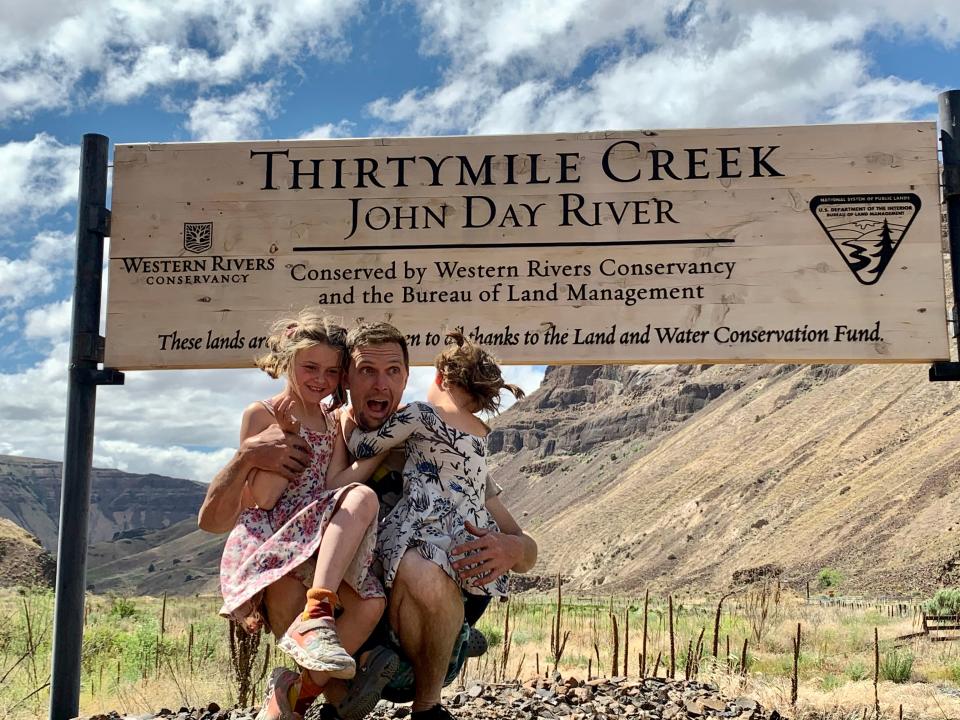
The John Day River permits, setup
The John Day is one of Oregon’s great rivers.
It’s the second-longest un-dammed river in the United States and cuts through deep canyons in a setting on par with a small-scale Grand Canyon. It’s typically floated in May and June when there’s enough water in the river and the weather is typically good — warm but not boiling.
The John Day is known for being a mostly mellow float, with only a handful of significant rapids and plenty of great campsites. That can make it a good option for younger kids.
Last spring, I wrote about how the opening of Thirtymile Boat Launch had made it possible to split up the river’s most famous section. A trip that once required 70 miles of floating — usually done over a week or more — can now be done in two halves: a 30-mile upper run (Clarno Boat Ramp to Thirtymile) and a 40-mile lower run (Thirtymile to Cottonwood Canyon State Park).
Map: See a map of John Day River segments
Last year’s trip down the lower section went so well with my then-5-year-old that I decided to return this year with both kids, now 4 and 6. After a few false starts, I was able to get a permit from Recreation.gov for the upper 30-mile run.
The upper stretch does have more challenging rapids, but having brought the kids down the North Santiam’s whitewater a number of times, I felt OK about it.
With permit in hand, I set up a shuttle for my car, made sure I had all the gear required — from that extra oar to a wilderness potty.
My good pal Hannah Hoffman, a former reporter for the Statesman Journal, was cool enough to come along and help with the girls.
Finally, in late May, it was time to hit the road.
Day 1: Singalong, and onto the river
I woke the girls up as early as possible on a Tuesday morning in late May, put them in the already-loaded rig and headed off for Santiam Pass and the other side of the Cascades.
The hope was that they’d sleep the first few hours in the car, but Lucy was too excited.
“Dad, let’s sing our mountains song!”
On long trips, we get bored so at one point invented our own little ditty to celebrate our trips into wild places. The mountain song goes like this:
Ooooh, it’s early in the morning
Before the sun can rise
Daddy and Lucy and Rollie
Are going for a drive
We’re not going north.
We’re not going west.
We’re going to the mountains, to have a big quest
Oooh, we’re going to the mountains
We’re gonna have some fun
We’re going to the mountains don’t worry everyone
We might run a river
We might see a bear
But we won’t know, until we get there.
There's a verse for the Coast as well, but I'll spare you.
After a stop at McDonald's and lots of Magic Tree House audiobooks, we arrived at a boat ramp and bridge in the middle of the high desert known as Clarno — not far from the Clarno unit of the John Day Fossil Beds National Monument.
We met Rita, our shuttle driver from Thirtymile Shuttles, who would drive our car and trailer to the take-out. She chatted with the girls while I got the boat ready.
“Is it just you three?” Rita asked.
“Nope,” I said. “Our friend should be here soon. Probably smart to have someone to hold onto the girls in Clarno Rapids, just in case things go sideways.”
Day 1: Near calamity, a thunderstorm
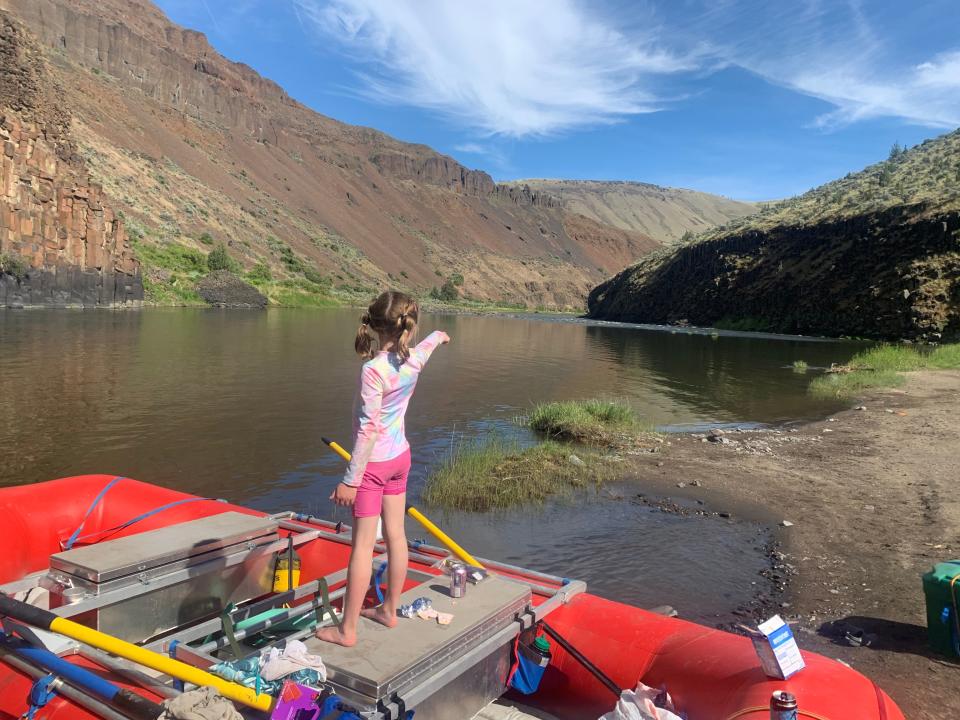
The first five miles of the John Day below Clarno is mellow.
The river floats through agricultural land before cliffs started to rise, the water picked up and I could tell we were entering the top of Clarno Rapids, the gateway to the wilder river. I parked the boat and scouted the rapids.
Here’s how the guidebook describes it: “Clarno Rapids, Class III-IV, is a three-fourths mile series of boulders, chutes and two main drops. It is different at every flow.”
As I scouted, I was looking for one main thing: Toward the end, there is a fence of boulders that requires running a narrow chute between rocks. At normal water levels, the chute is clean with just a wave below it — pretty easy. But as the river gets lower, a “tooth” rock appears that’s difficult to avoid in a large raft like mine.
“Dangit,” I said.
Oregon’s drought meant the river was lower than it should have been in late May, and the tooth rock was there. If it was just me, this wouldn’t be a major concern — rafts are made to hit rocks sometimes. But the idea of nailing the rock and jolting my 4-year-old into the water tied my stomach in knots.
When I returned to the boat, I discovered we were down one oar.
With a deep breath, I attached the new oar, pushed out into the river and pulled hard to the right, navigating around boulders in the upper part of the rapids without issue.
Then something caught Hannah’s eye.
“It’s our oar!” she said.
The wayward oar was sitting in an eddy just above the lower half of the rapids. I pulled over, grabbed it and attached it to the boat before continuing down waves and around rocks into the most challenging part of the rapids.
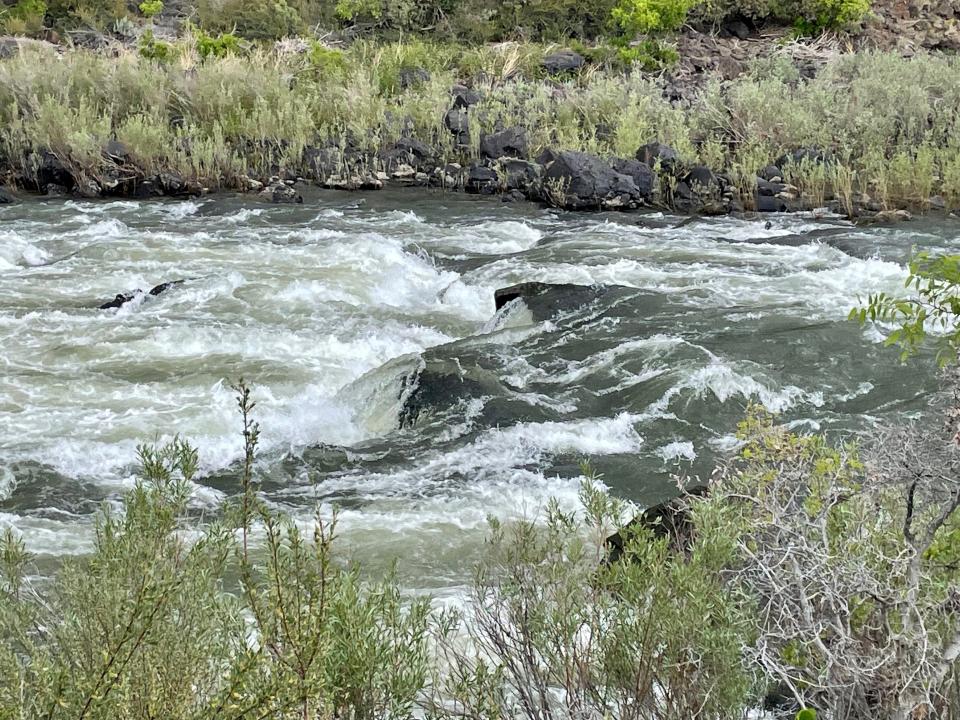
Finally, I saw the critical chute and lined up the boat.
As we swooped down it, I pulled hard right to avoid hitting the tooth rock head-on. But we still hit it, causing the raft to tilt sideways for just a moment. Hannah held both girls tight and the boat flopped back down as we continued around more boulders and waves before exiting the whitewater.
“Scary,” said Lucy.
“Wow,” said Hannah.
“I need a beer,” I said.
Just downstream, the girls spotted a nice campsite on the right. After a big day, we decided to stop early.
Then we felt the first drop of rain.
Setting up camp wasn’t bad, but as the rain grew heavier, we went inside the tent and played cards. When the rain passed it was still warm outside, so the girls and I hiked into the desert hills above our campsite while Hannah caught a much-deserved break in the hammock.
The air smelled of sage and juniper as we climbed to views of a canyon wilderness below a blue sky mixed with dark clouds, with sunshine shimmering off the rain falling in the distance.
I was proud of my girls. It had been a long and sometimes scary day. But here, with Lucy’s rainbow skirt flapping in the wind and Rollie searching for the pink flowers that bloomed on local cactus, they were undaunted and ready for more adventure.
Day 2: Deep into the canyon
At its best, the John Day River morphs into a floating dream: huge canyon scenery, warm desert temperatures, great fishing, occasional rapids and campsites with sand beaches.
For us, day two brought all of the above. Well, kind of.
We started off with some fun rapids, a bouncing set of Class IIs that splashed the girls in the face but this time in a fun way. After a short first day, we needed to make some river miles, so I rowed pretty hard, hoping to get below Basalt Rapids (Class II-III) by lunchtime and do some fishing.
Last year, Lucy and I caught tons of smallmouth bass from the raft, and I wanted that same experience for Rollie this year. But it turns out that managing two small children’s access to sharp fishing hooks is as easy as teaching cats to play poker.
First, I tried having them take turns fishing. This did not go well.
“Why does Lucy get to fish? I WANT TO FISH!” screamed Rollie.
Then I tried to have both fish with Hannah’s help. This immediately resulted in a lure getting stuck in the raft’s bowline just as I had to jump back on the oars to navigate a set of rapids.
Just after noon, we looked downstream and saw a gigantic chunk of basalt rock, roughly the size of a house, sitting in the river on the left — indicating the start of Basalt Rapids. Happily, it was pretty easy to navigate down the right side.
Below, we entered the deep canyon.
Cliffs rose thousands of feet overhead as the river squeezed into narrow gorges with rocks layered with stripes of reds, blacks and browns overhead.
In the afternoon heat, I jumped off the boat and into the water.
“Bye-bye girls,” I said, lying in the water with my lifejacket. “You guys can row the next set of rapids, right?”
As the afternoon wore on, we turned our attention to finding a campsite, one of the most important decisions of any raft trip. The map showed plenty of options, but we spotlighted one at a bend in the river.
The decision paid off.
As we came around the bend, we saw a big sand beach sticking out below Red Wall — a cliff that rises 2,300 feet overhead with columnar basalt. It was one of the most beautiful campsites I’ve ever seen.
We slowly unloaded the boat, carrying the gear into the shade of a cluster of juniper trees. Both girls spent their time splashing in the water and lying in the sand.
Later, I set up our table and art supplies and the girls colored pictures of our raft, campsite and adventure while we grilled cheeseburgers with apples and Caesar salad.
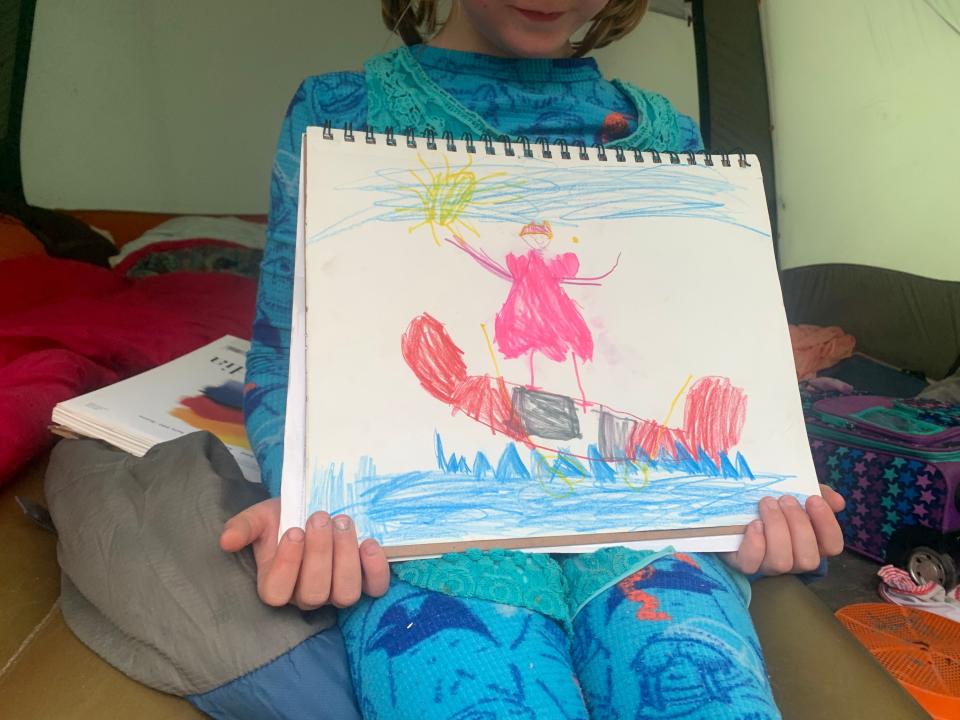
In the evening, we made a campfire and s’mores. We brought a special fire pan and used our own firewood, packing out the ashes afterward. Leave No Trace is not a suggestion here — it’s a way of life. Everything comes with you. Nothing is left behind.
The stars eventually came out, sparkling in the desert night.
Day 3: Windstorm and homeward
The final day of our trip got off to an inauspicious start.
The dreaded winds arrived — a phenomenon that often bedevils boats on the John Day.
Since it was our last day, Hannah made blueberry pancakes for breakfast while I packed up the boat to try and get an early start. We pushed off and immediately rode the high highs and low lows of a windy day.
In some canyons, the wind pushed us forward with ease. I lay back as the river’s current and wind pushed us downstream, through towering rock formations.
But then we’d come around a bend to find the wind pushing against us with gusts I’d estimate at 20 mph. The girls curled up in their jackets in the fetal position as I pulled as hard as I could to make any sort of progress downstream.
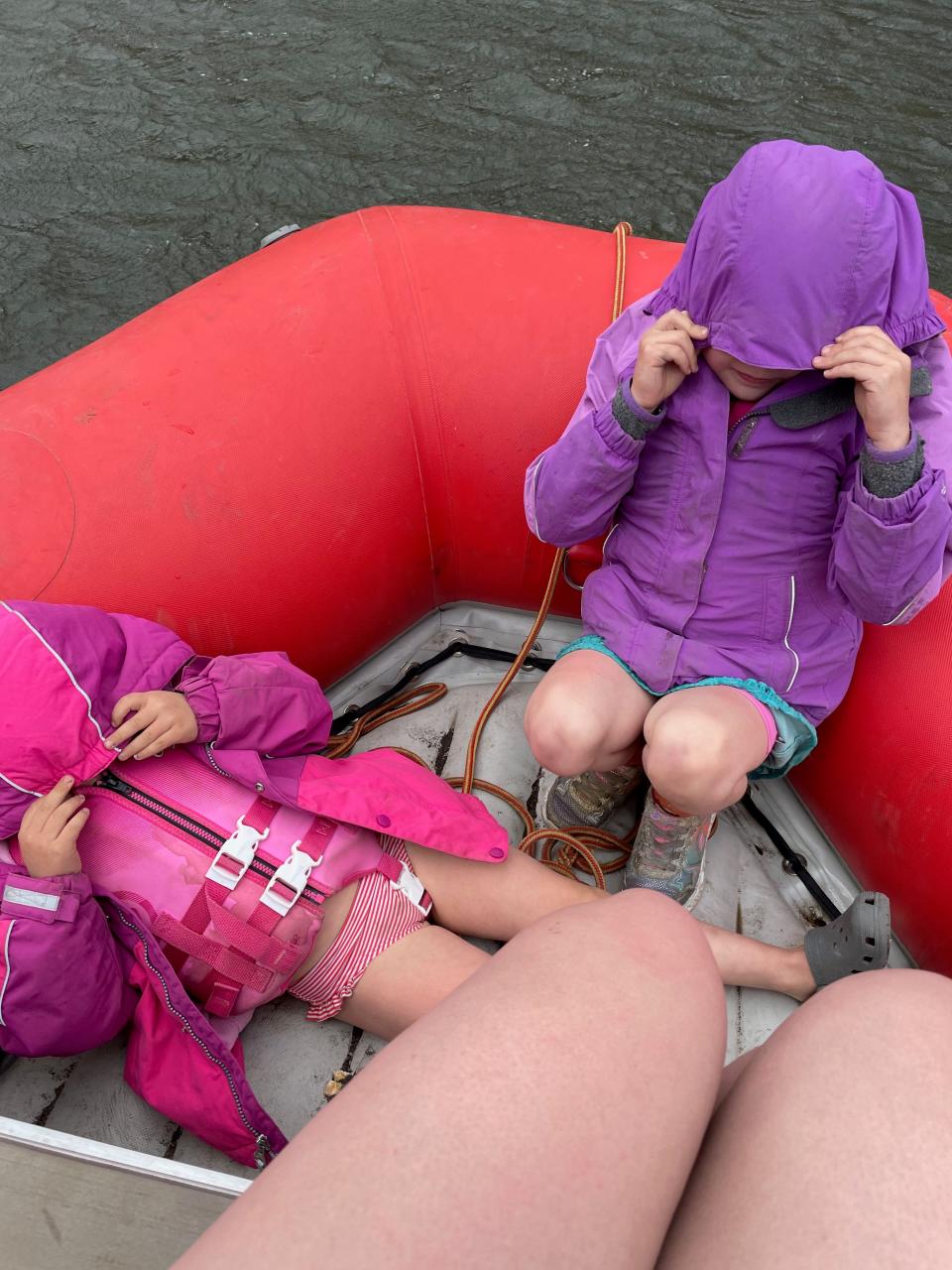
At about noon, we looked up the canyon and saw signs of civilization — a road that marked Thirtymile Boat Launch, a remote outpost that represented the end of our journey.
We reached the takeout to find a motley crew of boaters waiting to start their John Day adventure on the river's lower 40 miles. We shared beer and stories and they helped pull our raft onto my trailer. We discovered we had mutual friends and by the time it was over, I was half thinking about following this band of happy seafarers downstream for another 40 miles.
Hannah and the kids did not seem jazzed about this idea. Our trip through wind, rain, sunshine and near-calamity was enough to satisfy the adventure tank for now. And almost as soon as we started driving out of the canyon, Rollie was asleep, dreaming sweetly, I hope, about our next trip down the John Day River.
John Day River
In a nutshell: An overnight wilderness rafting trip through the Oregon canyonlands.
Required: Limited entry permit needed to float May 1-July 15, bought via Recreation.gov.
Segments: There are multiple segments of the John Day that all require different distances and skills. Find maps and info at: https://www.blm.gov/programs/recreation/permits-and-passes/lotteries-and-permit-systems/oregon-washington/john-day-river.
Info: Prineville District BLM, (541) 416-6700, blm_or_pr_mail@blm.gov.
Most famous float: Clarno to Cottonwood Canyon (70 miles or one week); Clarno to Thirtymile Boat Launch (30 miles and three days); Thirtymile to Cottonwood (40 miles and three to four days).
Equipment needs: Everything for a fully self-supported trip including: wilderness toilet you bring down in the boat, all the water you’ll need, an elevated fire pan for campfires (when allowed) and the ability to pack out all garbage, including ashes.
Zach Urness has been an outdoors reporter, photographer and videographer in Oregon for 13 years. Urness is the author of “Best Hikes with Kids: Oregon” and “Hiking Southern Oregon.” He can be reached at zurness@StatesmanJournal.com or (503) 399-6801. Find him on Twitter at @ZachsORoutdoors.
This article originally appeared on Salem Statesman Journal: How to safely take children rafting on John Day River

